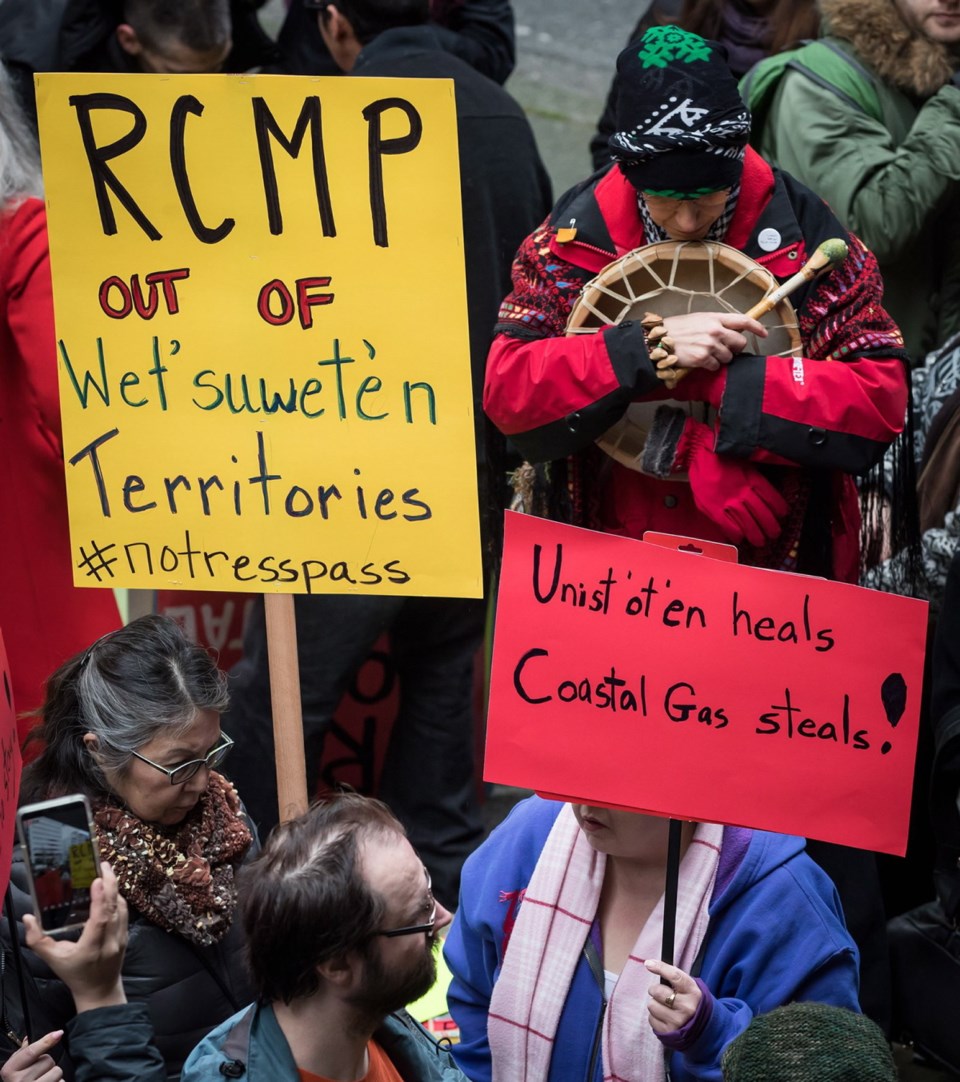By what right did the state deploy armed force against Indigenous Peoples and their allies at Wedzin Kwah?
The Wet’suwet’en peoples, their five clans, and numerous family are not merely demonstrators protesting oil and gas development — they are protecting their lands, as is their responsibility as the original peoples of the land.
Indigenous Peoples, their identities, languages, cultures and worldviews are inseparable from the land. Their lands have never been ceded or sold, and their nations have never been conquered.
Over 30 years ago, the Wet’suwet’en peoples with their Gitksan allies went to court, where hereditary chief Delgam Uukw stated: “For us, the ownership of territory is a marriage of the chief and the land. Each chief has an ancestor who encountered and acknowledged the life of the land. From such encounters come power. The land, the plants, the animals and the people all have spirit — they all must be shown respect. That is the basis of our law.”
For a W̱SÁNEĆ person, it is really important to support the Wet’suwet’en peoples, because their struggles are essentially what all Indigenous nations in B.C. face. Indigenous Peoples have lived on their respective territories for many thousands of years, and had developed complex and intense relationships to the natural world.
This relationship is often expressed through Indigenous languages, which articulate Indigenous worldviews. As an example, the W̱SÁNEĆ peoples spoke SENĆOŦEN (a Straits Salish Language) and called the lands and waters of the Salish Sea home for millennia.
Our SENĆOŦEN word for land is TEṈEW̱ . While this word can be translated into “land” or “earth,” it also has a deeper meaning. Literally, it would translate into “my wish for the people,” which refers to the land as a gift to us from the creator. A gift that was meant for us to exist as W̱SÁNEĆ people with our W̱SÁNEĆ identity and worldview.
The land was a gift that was invaluable, and could not be ceded or sold within the W̱SÁNEĆ worldview.
In the SENĆOŦEN language, many parts of the natural world were referred to as relatives. Salmon, trees, deer, killer whales, even land forms were all considered to be relatives with human-like spirits. Within this relationship, there was a responsibility to each other and a relationship that could not be ceded or sold. We are here to protect them, as much as they are there for us.
For the Wet’suwet’en peoples also, the land is fundamental to their nationhood.
What has happened at Wedzin Kwah is central to the history of B.C. and Canada — colonialism’s theft of Indigenous lands, and the imposition of foreign sovereignties and laws over Indigenous nations and the forced assimilation of Indigenous peoples into Eurocentric ways.
If this characterizes colonization in Canada, it is not just a problem of our past — it is what led to the 14 Wet’suwet’en people arrested as RCMP broke the gate at the Gidimt’en camp checkpoint.
For non-Indigenous peoples in this province, is it not time to seriously reflect on what is happening here?
By what right did the RCMP impose exclusion zones, erect roadblocks, bar media from the area and proceed to attack the peaceful land defenders at the Wet’suwet’en checkpoints?
Coastal GasLink, a branch of TransCanada pipeline, wants to build a pipeline to ship “fracked” gas to the coast.
It is a project promoted by the provincial NDP and federal Liberals, even though it will create huge carbon emissions.
The Wet’suwet’en oppose the pipeline coming through their traditional territories. The courts issue an injunction and then have it enforced.
Violent repression of a peaceful protest occurs.
Though ostensibly a function of the courts alone, this armed intervention at Wedzin Kwah was perpetrated by the “Crown” (the governments, courts and armed forces) based on what they believe is their sovereign power to do so.
In this case, however, the Crown might have mis-stepped. We are now faced with competing assertions of sovereignty and, in the absence of any alternative, we will all need to decide, which side are we on?
According to the courts (including the Supreme Court of Canada), the Crown obtained sovereignty over what is today called British Columbia only in 1846, when the British and American empires divided up the Pacific territories.
This claim, however, was based on the discredited “Doctrine of Discovery,” the idea that because captains Cook, Vancouver and others visited here, they had the right to claim territories occupied by Indigenous Peoples and governed by hereditary chiefs.
Even at the time, the notion of claiming sovereignty was challenged: A British philanthropist told the British foreign secretary that there were more than 100,000 Native people in the area “to whom it rightfully belongs, and not in equity to either of the nations claiming the same.”
Further undermining the Crown’s assertion of sovereignty is the widely recognized fact that for 140 years, the provincial government refused to even discuss treaties, despite persistent requests by First Nations. Instead, the governments conspired in 1927 to make it illegal for First Nations to even go to court to press their case.
The case for Crown sovereignty is poor. On the other hand, the First Nations case for sovereignty is strong and also offers a potential path forward to ending the pillaging of the earth.
If you’re “woke,” John Horgan and Justin Trudeau, Indigenous sovereignty is “lit.”
Get with the program. The world is watching.
Nicholas XEMTOLTW Claxton is W̱SÁNEĆ and assistant professor in the School of Child and Youth Care, and John Price is third-generation Scottish-Canadian and professor emeritus of history, both at the University of Victoria.



